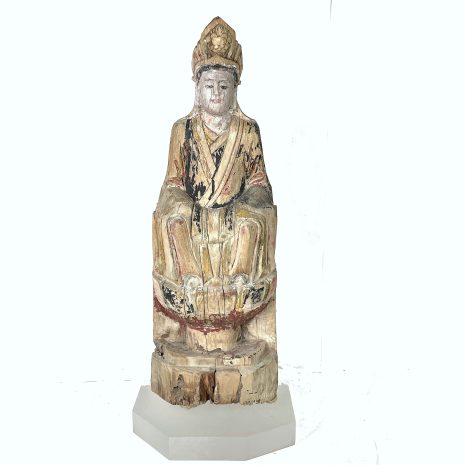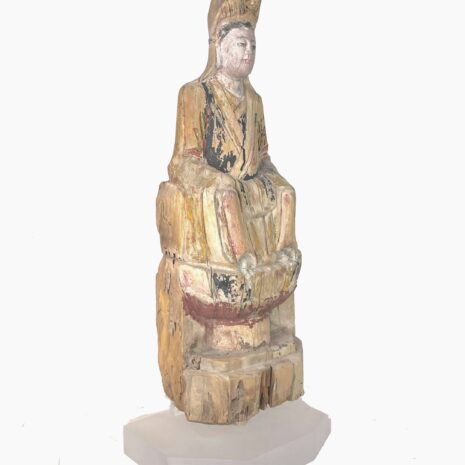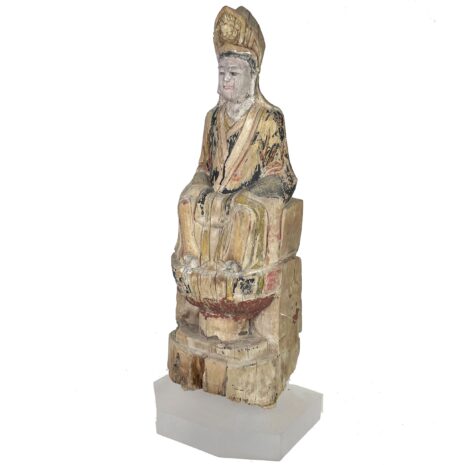SOLD Antique Carved Guanyin on Lotus Pedestal, China
$1,375.00
SOLD H: 23.25″ W: 9.25″ D: 6.25″
This Guanyin image was probably one of a pair of images along with the Taoist Queen Mother of the West (16206A-WACK) placed together on a community, local temple or home altar. Created by the same local artisan, they are provincial rather than imperial style having a humble, unadorned and simple rendering, seated on backless thrones, hands covered by a ritual cloth, uncharacteristic of Guanyin but common for Taoist goddesses. Both wear layered robes and a high pointed crown – the Queen Mother’s centered by a phoenix and Guanyin’s by a flower surrounded by symbolic aureole of radiating light. Both have soft blissful smiles with eyes cast slightly downwards to engage their devotees. Initially covered in bright polychrome colors, there are traces of surviving red, yellow, green, brown and black.
Out of stock
Description
Irvin identifies Guanyin and the Queen-Mother of the West as two of three of the Great Chinese Goddesses, all who were imperially sanctioned and revered by all sectors of society with small local shrines, large temples and monasteries dedicated to them. They are syncretic deities embraced by Popular Folk Religion, Taoism and Buddhism, share the feminine principles of compassion and are protectors who grant health, long life and safety to all devotees regardless of social class. Guanyin and the Queen Mother share roles as guides to a serene death: in Mahayana Pure Land Buddhism, Guanyin leads deceased souls to rebirth in the Buddhist Western Paradise, which is similar to the Taoist realm into which the Queen Mother guides the deceased. Thus, these two Qing dynasty images were probably carved by the same artisan to be placed together in one sanctified location most likely a home altar. She displays many of the features of Guanyin images: a lotus-throne (padmapitha), a gentle, calm and sweet face reflecting infinite wisdom, serenity, love and compassion and half-closed almond eyes which indicates the harmony of outer and inner life, half focusing on the outer world, and half internally for self-reflection, and radiating rays like an aureole around a flower on her crown symbolizing Amitabha-Buddha, the Buddha of Infinite Light. Since it originally was likely presented alongside the Queen Mother image (16206A-WACK), we recommend purchasing and displaying them together. The back cavity attests to its having been consecrated. The base is somewhat eroded with a loss in front and the carving has old but stabilized insect damage and surface cracks none of which is structural, but attests to its age and is otherwise in very good condition. She is mounted on a frosted acrylic base. This is part of the VA Collection of Buddhist-Statues.
Click here for the Blog Consecrating Wooden Images to Imbue Them with A Life Force
Sources:
Lee Irwin, “Divinity and Salvation: The Great Goddesses of China,” in Asian Folklore Studies, Indiana University, Vol. 49, 1990, p. 53-68.
Additional information
| Place of Origin | China |
|---|---|
| Period | Antique, Qing Dynasty |
| Date | 18-19th Century |
| Materials and Technique | Wood |
| Dimensions (inches) | Ht: 23.25” W: 9.25” D: 6.5” |
| Dimensions (metric) | Ht: 59.05cm W: 23.49cm D: 16.51cm |
| Weight | 8.5 lbs |
| Condition | Very good, see description |
| Item Number | 16206B-WACK |
| Shipping Box Size | Oversized. Call 213-568-3030 or email [email protected] for shipping. |






